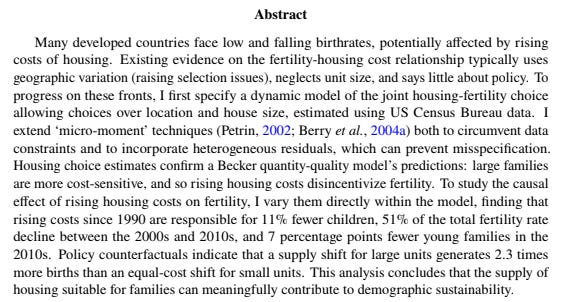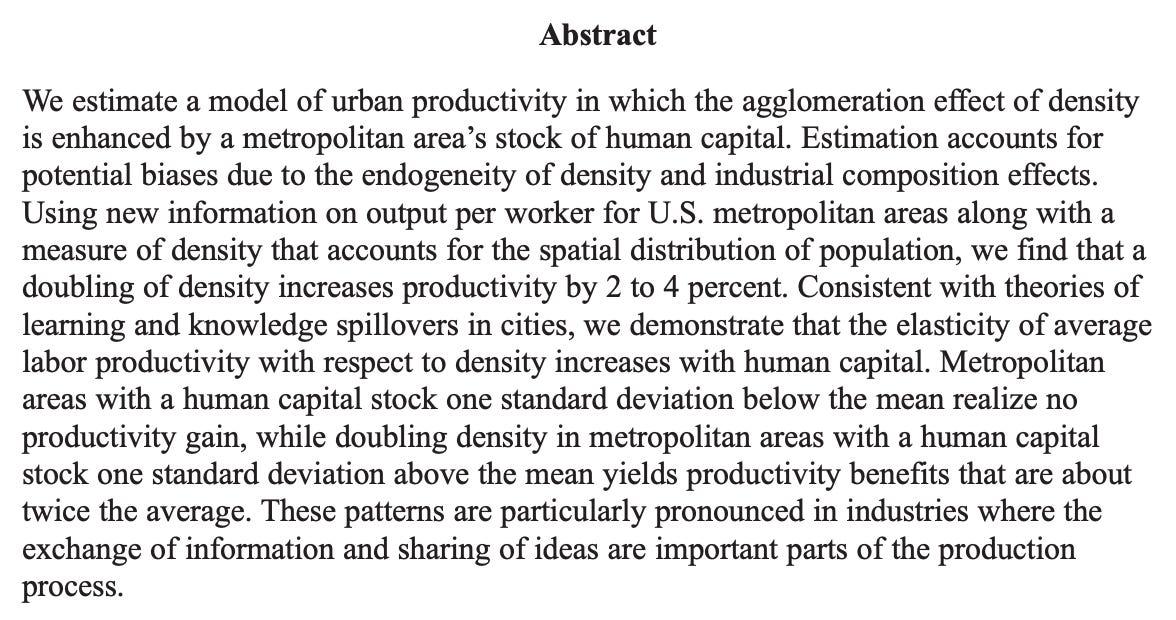Weekly Roundup #10
Housing | Rent control, Fannie & Freddie, fertility, and agglomerations
EXECUTIVE SUMMARY
Welcome back to the Boyd Institute’s roundup series. This week we published the first in a series of articles detailing in terms of of first principles why it is in the social, moral, and economic interest of the country for housing policy to prioritize the middle 80% of earners — the targeted upshot being higher rates of family formation:
Housing Policy Should Put Families First | Part One
Rather than subsidizing the outcomes of failure, policy should invest in the inputs to success
Expect the remaining parts of the series to be published over the next ~week. As for this week’s roundup, we have more on Pulte/Fannie & Freddie, rent control, the intersection of housing supply and fertility, how agglomeration effects interact with human capital mix, and some alternatives to YIMBYism in regards to policies that might boost housing affordability.
Newsflow:
New York landlords have filed suit arguing that the limits on what they can charge tenants constitutes a “taking”
Looks like Bill Pulte and the FHFA are exploring Fannie and Freddie taking stakes in tech companies because… reasons? — also seems they are gearing up for an IPO (we think this would be a mistake)
Fannie and Freddie eyeing portable or “assumable” mortgages
Academic research:
On how housing supply (and costs) have impacted fertility rates in the US, and typology matters enormously
On agglomeration, productivity, density, and knowledge spillovers from the concentration of human capital
Additional reading:
On housing unaffordability and what can possibly be done to make access to credit more widely available, as well as to progressively reform the tax code
NEWSFLOW
WSJ Opinion — Rent Control as a Constitutional Taking
A lawsuit was filed by building owners challenging the NYC’s rent “stabilization” law. The statute limits the rent increases a landlord can demand of existing tenants or new ones. Rent increases are limited to between 3% and 4.5% when a tenant renews an existing lease or when the apartment is vacated.
NYC’s low vacancy rate is made worse by rent regulations that have taken many of the city’s apartments off the rental market. After decades with long-term tenants, bringing many apartments back up to code would cost thousands of dollars that couldn’t be recouped at the artificially low rent cap. So the apartments sit vacant and off the market. According to the Census Bureau, in 2024 there were some 26,000 regulated apartments in NYC in this situation.
When rents are regulated so that a property can only be rented at a loss, the plaintiffs argue that it qualifies as a taking under the Fifth Amendment. Because New York’s rent restrictions mostly apply to buildings constructed before 1974, the rent stabilization is also arbitrary and violates equal protection and due process rights, says the suit.
The hope for those who oppose rent control is that the case, filed in federal court, makes it up to the Supreme Court. The Court has declined to hear recent rent-regulation appeals, but Justice Clarence Thomas has signalled interest. In a 2024 case in which the Court denied certiorari, Justice Thomas wrote regarding the denial that “In an appropriate future case, we should grant certiorari to address this important question.”
Bloomberg — FHFA’s Pulte Says Fannie, Freddie Eyeing Stakes in Tech Firms
Bill Pulte said that Fannie Mae and Freddie Mac are “looking at taking equity stakes in [technology] companies that are willing to give it to us because of how much power Fannie and Freddie have over the whole ecosystem.”
Pulte reiterated Friday that he thinks Fannie and Freddie will stay in conservatorship, with the government seeking to sell up to 5% of the entities. President Donald Trump’s administration has been weighing a stake sale, Bloomberg News earlier reported.
“I anticipate that the president will make a decision either this quarter or early next year as it relates to the IPO,” Pulte said.
National Mortgage News — Fannie, Freddie eyeing assumable or portable loans: Pulte
“At Fannie and Freddie, we are evaluating how to do assumable or portable mortgages in a safe and sound manner,” Pulte, who refers to FHFA as US Federal Housing, said in a social media post on X.
In the United States, the small but growing use of loan assumptions in conjunction with homebuying involves situations where the seller transfers their existing mortgage to the buyer, whereas in a country like Canada, borrowers may “port” their existing loan to a new property.
“Assumability stays with the house. Portability stays with you,” said Emmanuel Santa-Donato, senior vice president and chief market analyst at Tomo Mortgage. “In Canada, you can move the loan as long as the outgoing property value is higher.”
ACADEMIC RESEARCH
Build, Baby, Build: How Housing Shapes Fertility
Couillard (2025)
This study has been received as a something of a bombshell since its publishing last week. The prevailing consensus was as follows: zoning reform is good for affordability; more housing supply is better. Most research focused on aggregate supply elasticities (how much total housing quantity increases with regulatory loosening). Policy recommendations thus emphasized permitting more multifamily housing, smaller units, and density.
Couillard (2025), however, by explicitly modeling the joint decision problem using revealed preference data, suggests the above is necessary but insufficient — that the composition of supply matters enormously. Thus a policy that subsidizes construction of 1-bedroom units or relaxes zoning for apartments provides some affordability gain, but the fertility return is minimal because:
Small households (young professionals, couples without children, empty-nesters) benefit
Families with multiple children remain priced out even as affordable small units increase
The problem is not just price level but availability of adequate space at reasonable cost
The takeaway here is that large families are disproportionately cost-sensitive to housing compared to small families; rising costs suppress fertility not uniformly, but specifically by making the quantity-to-quality tradeoff unfavorable for families seeking multiple children. This directly challenges the implicit policy assumption of the 2010s-2020s that “build first, worry about composition later” is optimal. Couillard (2025) suggests it is not.
Productivity and the Density of Human Capital
Abel et al. (2011)
This study estimated a model of urban productivity establishing that density yields productivity gains, but the magnitude critically depends on a metro area’s human capital mix. The authors find that doubling density increases productivity by 2-4 percent overall, but this effect is highly conditional on skill levels. Notably, it found that metros with human capital one standard deviation below the mean realize essentially zero productivity gain from density increases, while those one standard deviation above the mean realize benefits ~2x the average. These patterns are most pronounced in industries where information exchange and idea-sharing are central to production.
Subsequent research has substantially validated this framework, particularly its central claim that agglomeration benefits are contingent on human capital stocks. Dingel’s (2024) research on skill-biased agglomeration provides perhaps the most sophisticated recent validation and extension of their work. Dingel’s analysis confirms that agglomeration effects are indeed skill-biased, with productivity elasticities to city size varying substantially across educational groups — bachelor’s degree holders show elasticity of 1.087, professional degree holders 1.113, while high school graduates show only 0.925. Critically, the findings on worker sorting indicate that roughly 67% of larger cities’ earnings premium derives from spatial sorting of workers by ability rather than productivity enhancements from density per se, substantially refining Abel et al.’s claim about genuine agglomeration effects versus selection effects.
ADDITIONAL READING
Improving Housing Affordability
Economic Strategy Group | Benjamin Keys & Vincent Reina
Since 1980, median inflation-adjusted rent has nearly doubled—from under $950 to $1,700 in 2023—while the share of affordable rental units has collapsed from more than half of the housing stock to just over 20 percent. The share of renters who are “rent burdened,” spending over 30 percent of their income on housing, has risen from 35 to 48 percent.
…
[H]omeownership has become increasingly out of reach. The ratio of median sales price to median income has increased from 2.4 in 1990 to 5 in 2023. With home prices elevated, first-time buyers are entering the market later and in smaller numbers. The median age of a first-time buyer has climbed from 29 in 1980 to 38 in 2024, and the share of all housing purchases made by first-time buyers fell from 50 percent in 2010 to 24 percent in 2024.
…
Developers and owners both face barriers when trying to finance new development, which affects the supply of new units being built, and rehabilitation, affecting the ability of units to stay in the housing stock. Since 2015, tighter credit standards have constrained developers, landlords of small properties, and homeowners seeking to rehabilitate aging housing stock.
…
The tax code can be reformed to reduce barriers to homeownership by converting the regressive mortgage interest deduction into a targeted first-time homebuyer credit while balancing demand-side incentives to avoid driving up prices. Policymakers could also explore taxes on imputed rent to encourage downsizing, make existing mortgages more assumable or portable, and expand tax-credit programs like the proposed Neighborhood Homes Tax Credit to support the development of affordable for-sale housing.







